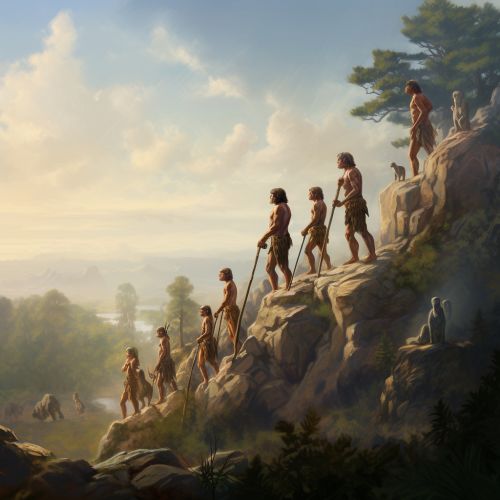Human Evolution
Overview
Human evolution is the lengthy process of change by which people originated from apelike ancestors. Scientific evidence shows that the physical and behavioral traits shared by all people originated from apelike ancestors and evolved over a period of approximately six million years. One of the earliest defining human traits, bipedalism -- the ability to walk on two legs -- evolved over 4 million years ago. Other important human characteristics -- such as a large and complex brain, the ability to make and use tools, and the capacity for language -- developed more recently. Many advanced traits -- including complex symbolic expression, art, and elaborate cultural diversity -- emerged mainly during the past 100,000 years.


Evolutionary History
Human evolution, the process by which human beings developed on Earth from now-extinct primates, is characterized by a number of morphological, developmental, physiological, and behavioral changes. The most significant of these adaptations are bipedalism, increased brain size, lengthened ontogeny (gestation and infancy), and decreased sexual dimorphism. The relationship of humans to the great apes has been confirmed by modern genetic studies. Humans are most closely related to the African apes, the chimpanzee, and the bonobo.
Bipedalism
Bipedalism is a form of terrestrial locomotion where an organism moves by means of its two rear limbs or legs. An animal or machine that usually moves in a bipedal manner is known as a biped, meaning "two feet" (from the Latin "bi" for "two" and "ped" for "foot"). Bipedal movements range from walking and running to hopping and skipping. While the majority of bipedal creatures are birds and mammals, it is not uncommon for other types of animals to adapt to this form of movement.
Brain Size and Complexity
The human brain is the main organ of the human nervous system. It is located in the head, protected by the skull and close to the primary sensory apparatus of vision, hearing, balance, taste, and smell. The human brain is the most complex object in the known universe. It is both the physical structure associated with the mind and consciousness, and the primary piece of machinery associated with mental functions and intelligence. The human brain is larger than any other primate's, both in absolute terms and relative to body size.
Tool Use and Development
The use of tools by early humans was partly a process of discovery and of evolution. Early humans evolved from a species of foraging hominids which were already bipedal, with a brain mass approximately one third of modern humans. Tool use would have evolved as a necessity for scavenging the kills of other predators, or for collecting water from hollow trees or rock crevices. Early humans began to manufacture stone tools about 2.6 million years ago, probably to aid in the butchering of animals.
Language and Symbols
Language is a system of symbols and rules that enable us to communicate. It is arguably the most important tool of human communication. We use language to share our thoughts, feelings, and ideas, to ask questions, to give orders, and to do countless other things. The capacity for language usually emerges in infants soon after the first birthday, and they make enormous progress in this area during their second year. Language development is a major achievement of early childhood.
Cultural Diversity
Cultural diversity is the quality of diverse or different cultures, as opposed to monoculture, the global monoculture, or a homogenization of cultures, akin to cultural decay. The phrase cultural diversity can also refer to having different cultures respect each other's differences. The phrase "cultural diversity" is also sometimes used to mean the variety of human societies or cultures in a specific region, or in the world as a whole.
